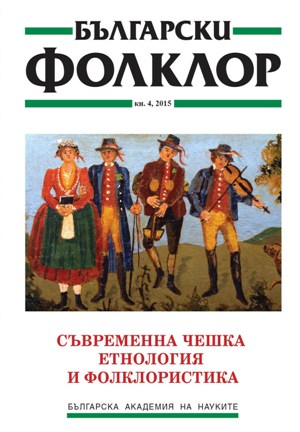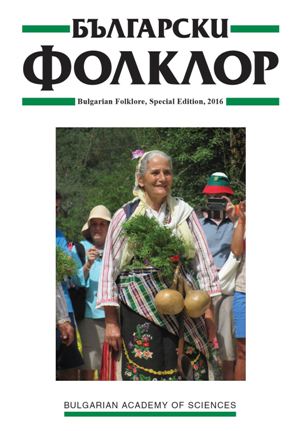
We kindly inform you that, as long as the subject affiliation of our 300.000+ articles is in progress, you might get unsufficient or no results on your third level or second level search. In this case, please broaden your search criteria.


The article focuses on the evaluation of erotic and expressive elements in Czech fairy tales and anecdotes. For historical reasons (late recording, self-censorship of the collectors, etc.) relatively few texts of this type have been preserved. Erotic motifs are present especially in jokes and humorous and novelistic tales, anecdotes and in a number of fairy tales. Eroticism is most often included in stories about infidelity, about courtship, in connection with the stupidity of the main character or villain. Based on the comments of some collectors as well as using comparative folklore studies, we are able to reconstruct the original form of some fairy tales with erotic elements. However, the possibilities of such a reconstructive method in research into verbal folklore are limited. A new dimension has been added to these methods by visual anthropology. The film trilogy by Pier Paolo Pasolini based on original folk tales can be regarded as an interesting way of artistic reconstruction of erotic folklore.
More...
Dance like obkročák, polka, and sousedská have become so familiar by now that there is no doubt about them being folk, national Czech dances; they have made their way as Czech dances into the works of prominent Czech composers such as Bedřich Smetana, Antonín Dvořák or Bohuslav Martinů. The research is mostly interested in what helped the dances gain the status of Czech folk ones as well as national dances, when, for whom and why they worked as symbols of Czech citizenship and in what way the concept of ‚national dance‘ developed.
More...
The collection of dance music manuscripts from the late 18th and early 19th century by Jiří Hartl is unique among European sources. Jiří Hartl was a skilled musician, playing the violin, clarinet, organ and bassoon. He was also responsible for the local organ, establishing a tradition of instrumental music. This is evidenced by his collection, which contains 840 dance instrumental melodies (1810– 1820). The records are those of the first violin with instrumentation glosses, solo contributions of other instruments, and the names of most of the dances. The collection also contains verbal notes, which help to reconstruct the composition of Hartl’s band. The manuscripts contains the dances ländler, steyrisch, schotisch/egosse, marsch, ungarisch, zweitritt, contra, menuetto, deutschen, hulán, třínožka, bauer, bažant, bonapart, englese, furiant, husa, kalamajka, kögeltanz, švihák. Hartl’s legacy and life story epitomize the versatile work of small-town teachers in Bohemia in the early 19th century – an essential support for cultural growth and a successful national emancipation movement.
More...
In 1950s Czechoslovakia, traditional folk music was officially presented as the most important resource of national musical identity. Folk- or folk-inspired music was almost omnipresent. Although this intensity was waned in the following decades, the role of the folk music as a symbol remained strong until the end of the communist rule in 1989. While the ideology of communism used folk music as its tool, it also influenced the way this music was collected, researched and presented. The paper presents examples from two closely intertwined areas documenting these issues: folk music research and folk music revival.
More...


This article outlines different approaches applied during ethnomusicological fieldwork on local folk musical traditions and cultures. It illustrates the transition from the accumulation of separate samples (songs and instrumental tunes) towards the reconstruction of the regional model and the musical-anthropological interpretation of music in a cultural context. The variety of fieldwork techniques and methodological tools allows the researcher to reveal territorial relatedness and the interdependence of musical elements and performance styles, to highlight local specificities in the functioning of folk music, and to note manifestations of local cultural inheritance in the living musical practices of today. In a reflexive perspective, the author discusses her own experience while participating in several projects of regional field research.
More...
The article is focused on three important aspects of intangible cultural heritage: the designation of intangible cultural heritage and the meanings imparted to it; the spheres of cultural activity within its scope, and the safeguarding measures which are implemented by the state. On the basis of the definitions and statements from UNESCO’s 2003 Convention for the Safeguarding of the Intangible Cultural Heritage, I offer an overview of the situation in Bulgaria: the growing usage of the new concept and the different contents attributed to it; the substantial discrepancies between the essence of intangible cultural heritage and the popular notions about it; some of the state’s cultural policies regarding the safeguarding of intangible cultural heritage; and the increased media focus on these issues. In the analysis of the current situation, I draw on my comprehension and experience as a researcher and as an expert involved in the implementation of some of the state cultural policies in this sphere.
More...
This article offers the concept of folklore nostalgia, derived from Michael Herzfeld’s definition of structural nostalgia as an aspect of the broader notion of cultural intimacy. The concept is discussed in regards to the areas of fieldwork within Bulgarian ethnology and folkloristics. The aim of creating this juxtaposition is not to formulate theoretical propositions, but rather to discuss the extent to which and directions in which the use of this concept would be applicable for the methodology of anthropologically oriented disciplines. The place of the internet is of particular importance here as a ‘new’ field and, at the same time, a ‘new’ source for anthropological research. Studying the specific type of communication on the internet—the characteristics of which resemble the folk(lore) interaction—it is highly interesting to explore this private sphere where interpretations of the official discourse, as presented by the media, take place.
More...
This paper is dedicated to the legend of seven maidens connected to Yedi Kızlar Türbesi (the Tomb of the Seven Maidens) in Manisa, the Republic of Turkey. Two versions of the legend are discerned: one (pseudo)historical and one ritual-mythical. The author shows that the former version is not actually based on historical facts. The second version is compared to legends which were recorded among the Turks of the Eastern Rhodope Mountains in Bulgaria. In this way, the paper outlines similarities in how the Seven Maidens are depicted in both regions. A comparison with a legend from Ossetia confirms the hypothesis that the Seven Maidens were originally a personification of the Pleiades star cluster. Owing to its peripheral position in relation to central religious issues, this cult was preserved during the Christian (Byzantine) and Muslim (Ottoman) periods, thus providing an opportunity for a manifestation of religiosity among women.
More...
This article is dedicated to the New Age pilgrimages in Bulgaria in the late 20th and early 21st centuries. It presents various types of pilgrim destinations: natural landmarks and cultural sites with a primarily religious character. Some specific aspects of the New Age pilgrimages in Bulgaria are outlined, such as the interest in ‘Thracian’ and ‘Proto-Bulgarian’ sites and beliefs, the influence of Dаnovism, and the inclusion of Orthodox religious centres in New Age sacred geography. The New Age pilgrimages are seen as a manifestation of postmodern religiosity, in which the leading idea is to acquire a personal experience of the respective sites of energy/power in the search for spiritual transformation.
More...
This paper addresses the specific situations faced by children of interethnic families relating to the ethnocultural, linguistic, and religious upbringing by their parents. The study focuses on persons born into Bulgarian-Russian, Bulgarian-Ukrainian, Bulgarian-Austrian, Bulgarian-Slovak, and Bulgarian-German families which reside in either Bulgaria or other European countries. An individual’s ethnocultural education is considered a part of the process of enculturation and socialization that occurs in the first few years of his or her life. In interethnic families, there are three cultural models that parents use to transmit their ethnic backgrounds to their descendants: the ‘one-sided arrangement’, ‘alternative arrangement’, and ‘creative adjustment’. The linguistic education includes the different means chosen by parents for transmitting their language competence to their offspring. The discussion of religious upbringing is based on data from people raised with two cultures and two festivity systems, and their family practices regarding religious holiday celebrations.
More...![Bulgarian Folk Music in Four Volumes as Part of the Series Collection of Folklore and Ethnography [Сборник за народни умотворения и народопис]. Sofia: Professor Marin Drinov Academic Publishing House, 2007, 2009, 2012](/api/image/getissuecoverimage?id=picture_2016_24533.jpg)

![Holy Places in the Region of Sofia: Cults, Narratives, Images [Свети места в Софийско: култове, разкази, образи]. Edited by Albena Georgieva. Sofia: Professor Marin Drinov Academic Publishing House, 2013](/api/image/getissuecoverimage?id=picture_2016_24533.jpg)
![Vihra Baeva. Miracle Stories: Local Tradition and Personal Experience. Second Enlarged and Revised Edition [Вихра Баева. Разкази за чудеса. Локална традиция и личен опит]. Sofia: Professor Marin Drinov Academic Publishing House, 2013](/api/image/getissuecoverimage?id=picture_2016_24533.jpg)
![Humor: Views, Practices, Techniques [Хуморът: прочити, практики, техники]. Edited by Dafina Stefanova, Stanoy Stanoev. Sofia: Professor Marin Drinov Academic Publishing House, 2013](/api/image/getissuecoverimage?id=picture_2016_24533.jpg)

